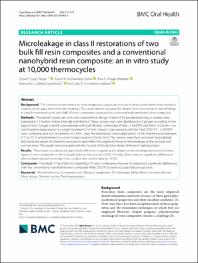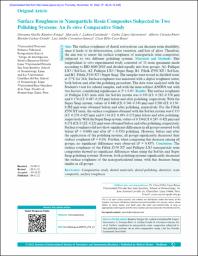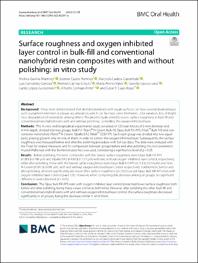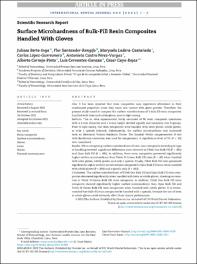Mostrar el registro sencillo del ítem
Microleakage in class II restorations of two bulk fll resin composites and a conventional nanohybrid resin composite: an in vitro study at 10,000 thermocycles
| dc.contributor.advisor | Alvarez, Jenny | |
| dc.contributor.author | Cayo‑Rojas1, César Felix2 | |
| dc.contributor.author | Hernández‑Caba2, Karen K | |
| dc.contributor.author | Aliaga‑Mariñas2, Ana S. | |
| dc.contributor.author | Ladera‑Castañeda1, Marysela I.2 | |
| dc.contributor.author | Cervantes‑Ganoza3, Luis A | |
| dc.date.accessioned | 2021-12-16T18:53:09Z | |
| dc.date.available | 2021-12-16T18:53:09Z | |
| dc.date.issued | 2021-10-28 | |
| dc.identifier.uri | https://hdl.handle.net/20.500.14308/3441 | |
| dc.description.abstract | Background: The contraction presented by resin composites causes an increase in stress at the tooth-resin interface, causing micro-gaps that allow microleakage. This study aims to evaluate the degree of in vitro marginal microleakage in class II restorations with two bulk fll resin composites compared to a conventional nanohybrid resin composite. Methods: The present study was an in vitro experimental design. A total of 30 standardized class II cavities were prepared in 15 human molars (mesially and distally). These cavities were later distributed in 3 groups according to the type of resin. Groups A and B were restored with bulk fll resin composites (Filtek—3 M/ESPE and Tetric N-Ceram—Ivo‑ clar/Vivadent respectively) in a single increment of 4 mm. Group C was restored with the Filtek Z350 XT – 3 M/ESPE resin composite and two increments of 2 mm. Later, the restorations were subjected to 10,000 thermocycles between 5 °C to 55 °C and immersed in a silver nitrate solution (1 M for 24 h). The crowns were then sectioned mesiodistally and observed under the stereomicroscope to determine the degree of marginal microleakage at the occlusal and cervical areas. The results were analyzed with the Kruskal–Wallis and the Mann–Whitney U statistical tests. Results: There were no statistically signifcant diferences regarding the degree of microleakage between the three types of resin composites in the occlusal and cervical areas (p>0.05). Similarly, there were no signifcant diferences after comparing each resin type in its occlusal and cervical area (p>0.05). Conclusion: Filtek Bulk Fill and Tetric N-Ceram Bulk Fill resin composites showed no statistically signifcant diferences with the conventional nanohybrid resin composite Filtek Z350XT at both occlusal and cervical areas. Keywords: Monoblock resin, Composite resin, Marginal adaptation, Microleakage, Molar, Mono incremental resin, Silver nitrate, Thermal cycling, Tooth preparation | es_PE |
| dc.format | application/pdf | es_PE |
| dc.language.iso | en | es_PE |
| dc.publisher | BMC Oral Health - Microfiltración Bulk Fill y nanohíbrida | es_PE |
| dc.rights | info:eu-repo/semantics/openAccess | es_PE |
| dc.rights | Attribution-NonCommercial-NoDerivs 3.0 United States | * |
| dc.rights.uri | licenses/by-nc-nd/3.0/us/ | es_PE |
| dc.rights.uri | http://creativecommons.org/licenses/by-nc-nd/3.0/us/ | * |
| dc.source | Universidad Privada San Juan Bautista | es_PE |
| dc.source | Repositorio Institucional UPSJB | es_PE |
| dc.subject | Monoblock resin, | es_PE |
| dc.subject | Composite resin, | es_PE |
| dc.subject | Marginal adaptation, | es_PE |
| dc.subject | Microleakage, | es_PE |
| dc.subject | Molar, | es_PE |
| dc.subject | Mono incremental resin, | es_PE |
| dc.subject | Silver nitrate, | es_PE |
| dc.subject | Thermal cycling, | es_PE |
| dc.subject | Tooth preparation | es_PE |
| dc.title | Microleakage in class II restorations of two bulk fll resin composites and a conventional nanohybrid resin composite: an in vitro study at 10,000 thermocycles | es_PE |
| dc.type | info:eu-repo/semantics/article | es_PE |
| dc.subject.ocde | http://purl.org/pe-repo/ocde/ford#5.01.01 | es_PE |
| dc.publisher.country | Perú | es_PE |
| dc.date.embargoEnd | 2021-12-15 | |
| dc.type.version | info:eu-repo/semantics/publishedVersion | es_PE |





